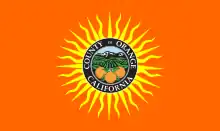Orange Curtain
The Orange Curtain is a local term for the border between Orange County and Los Angeles County in the U.S. state of California.[1] It is a sometimes derogatory, sometimes lighthearted term that is used to describe Orange County's more conservative and suburban population as compared to the more liberal and urban population of Los Angeles.[2][3][4]


The phrase is a wordplay on the so-called Iron Curtain, which separated communist and capitalist Europe.[5]
According to Colleen Cotter, "Because [Orange County] has a reputation for political conservatism, people from Northern California especially worry about what happens 'Behind the Orange Curtain'."[4]
The Orange Curtain began from the fact that between 1890 and 1950, Orange County was wholly white and "the region's predominately Irish settling also embraced an ideology of small government.[6]
Following the 2018 midterm elections, in which liberal Democrats were elected to all seven congressional seats in Orange County, comments arose about the so-called collapse of the Orange Curtain. A Republican Party political consultant said, "Orange County was different. It was, as we called it, 'the orange curtain' and it has now fallen."[7]
Some argued the strict measures imposed during the COVID-19 pandemic and the opposition to them by local conservatives caused a swelling of Republican support throughout Southern California in 2020, returning parts of the County to its conservative roots.[8] In this way, the resurrection of the Orange Curtain was pushback against Democratic governor Gavin Newsom, who at times, singled out Orange County in lockdown measures;[9] Newsom was rebuked in this effort by Orange County Board of Supervisors Chairwoman Michelle Steel, who labeled his orders an “overreaction and abuse of power.”[10][11] Following the 2020 general elections, Steel and fellow Republican Young Kim took back two of Orange County's congressional districts (Kim in the 39th and Steel in the 48th, respectively) from one-term Democrats Harley Rouda and Gil Cisneros, respectively.[12]



References
- Dickson, Paul (2006). Labels for Locals: What to Call People from Abilene to Zimbabwe (Revised ed.). HarperCollins. p. 174. ISBN 978-0-06-088164-1. Retrieved 2011-02-10.
The term "Orange Curtain" is being used to mark those characteristics, real or imagined, that differentiate Orange County from Los Angeles and the rest of California.
- Overley, Jeff (January 4, 2008). "Are we on TV too much?". Orange County Register. Retrieved 2008-04-08.
- http://www.doubletongued.org/index.php/dictionary/orange_curtain/
- Cotter, Colleen (2001). Lonely Planet USA Phrasebook: Understanding Americans & Their Culture (Lonely Planet Phrasebooks). Hawthorn, Vic., Australia: Lonely Planet Publications. p. 199. ISBN 1-86450-182-0.
- Jennifer Lefurgy; Lang, Robert (2007). Boomburbs: the rise of America's accidental cities. Washington, D.C: Brookings Institution Press. p. 165. ISBN 978-0-8157-5114-4.
- Aguilar-San Juan, Karin (2009). Little Saigons: staying Vietnamese in America. Minneapolis: University of Minnesota Press. p. xii. ISBN 978-0-8166-5486-4.
John Birch-style ideology.
- Keith, Tamara (November 20, 2018). "Democrats Demolish The 'Orange Curtain' In Orange County". NPR. Retrieved September 2, 2020.
- Green, Miranda (October 21, 2020). "The Mask Backlash That Could Oust a Democratic Congressman". Intelligencer. Retrieved November 21, 2020.
- "200-Plus Gather In Huntington Beach To Protest Stay-At-Home Order: We've Complied Long Enough". abc7.com. April 20, 2020. Archived from the original on April 21, 2020. Retrieved April 23, 2020.
- CUSTODIO, SPENCER (April 30, 2018). "Orange County Officials Urge Gov. Newsom to Rethink Beach Closures". Voice of OC. Retrieved November 21, 2020.
- "Newsom closes all Orange County beaches. Local officials call it an 'act of retribution'". Politico. April 30, 2020. Retrieved November 21, 2020.
- Do, AHN (November 15, 2018). "Three Korean American women win seats in Congress". Los Angeles Times. Retrieved November 21, 2020.